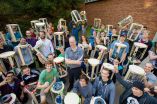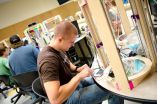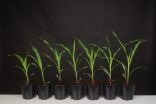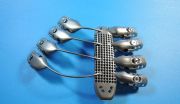Making a difference with open source science equipment
2015-09-11
(Press-News.org) Open source lab equipment is the focus of a new study, published in Science and Public Policy. Joshua Pearce, an associate professor of materials science and engineering as well as electrical and computer engineering at Michigan Tech, led the research. Pearce proposes that instead of spending millions of dollars every year replacing quickly obsolescent equipment, that money could be redirected to developing open source tools that are "upgradeable and transformable--they will be continuously updated" using digital manufacturing techniques such as 3-D printing.
The benefits could be huge: research would cost less, the equipment would improve each year, grant competition would be less inflamed and educational tools would provide better inspiration and instruction. Outside the lab, open source tools could help spur innovation and diversity in the science manufacturing market. While these big effects would take time to grow, Pearce and his Michigan Tech Open Sustainability Technology lab did quantify the impact of open source syringe pumps.
Pearce and his group created 3-D printable models--completely customizable--for $97 for a single pump and $154 for a double pump, using open source CAD software and off-the-shelf motor parts. They posted the designs and codes on Youmagine and Thingiverse; within ten months, they had 1,035 downloads. And each download counterbalances the cost of purchasing a syringe pump.
"You look at our syringe pump, and it's way better than the low end ones," Pearce says. " And it matches performance of high end syringe pumps that anyone can build themselves."
To calculate a return on investment, the team examined the download substitution value. Basically, they took the price of a syringe pump and the cost of manufacturing their own tool design--the difference between them represents a savings. Then they multiplied that savings by the number of people who downloaded the design and made the tool. Pearce and his team estimate the return on investment for this case study is between 460 percent and 12,000 percent.
Another key point of Pearce's research is that calibrating open source devices and ensuring quality is invaluable. The problem is that there is currently no way to track that validation.
"That's where the initial funding comes in," Pearce says, adding that the National Science Foundation (NSF), National Institutes of Health (NIH) and other major funders could make a big difference in improving open source validation. "They can also build a centralized database to house that information--including the code--and make the hardware more accessible."
Until those databases exist, Pearce plans to keep improving open source tools, one syringe pump and download at a time.
INFORMATION:
[Attachments] See images for this press release:


ELSE PRESS RELEASES FROM THIS DATE:
2015-09-11
The politics of climate change are often depicted as a simple battle, between environmentalists and particular industries, over government policy. That's not wrong, but it's only a rough sketch of the matter. Now a paper co-authored by MIT economist Christopher Knittel fills in some important details of the picture, revealing an essential mechanism that underlies the politics of the climate battle.
Specifically, as Knittel and his colleagues demonstrate, at least one climate policy enacted by Congress -- on transportation fuels -- contains a crucial asymmetry: It imposes ...
2015-09-11
The aging process is associated with declines in brain function, including memory and how fast our brain processes information, yet previous research has found that higher levels of cardiorespiratory fitness in older adults leads to better executive function in the brain, which helps with reasoning and problem solving. Higher cardiorespiratory fitness levels have also been found to increase brain volume in key brain regions.
A new study from a team at the Beckman Institute for Advanced Science and Technology at the University of Illinois reveals the connection between ...
2015-09-11
UPTON, NY--In the Daya Bay region of China, about 55 kilometers northeast of Hong Kong, a research project is underway to study ghostlike, elusive particles called neutrinos. Today, the international Daya Bay Collaboration announces new findings on the measurements of neutrinos, paving the way forward for further neutrino research, and confirming that the Daya Bay neutrino experiment continues to be one to watch.
The latest findings involve measurements that track the way neutrinos change types or flavors as they move, a characteristic called neutrino oscillation. By ...
2015-09-11
VIB and UGent scientists have developed a new method which allows them to predict the final size of a plant while it is still a seedling. Thanks to this method, which is based on the knowledge that a set of genes is associated with the final size of a leaf, scientists will be able to significantly accelerate plant breeding programs. The VIB/UGent scientists were able to identify this set of genes through advanced and highly detailed analyses. Expression analysis of specific genes will help breeders select the most useful crossing products at a very early stage.
Smart ...
2015-09-11
Tyrosine kinase 2 (Tyk2) is an enzyme involved in intracellular signalling and has an important role in activating the immune system. But enzymatically active Tyk2 can also promote excessive immune reactions and growth of certain cancer types.
Since several years, scientists are developing substances to specifically inhibit the kinase activity of Tyk2 for the treatment of inflammatory diseases and for potential use in cancer therapy. However, complications may occur: Tyk2 crucially contributes to the maturation and activation of natural killer (NK) cells. NK cells form ...
2015-09-11
After being diagnosed with a chest wall sarcoma, a 54-year-old Spanish man's surgical team made the decision to remove his sternum and a portion of his rib cage and replace it with an implant.
The implant was designed and manufactured by medical device company, Anatomics, who utilised the CSIRO's 3D printing facility, Lab 22 in Melbourne, Australia.
The surgical team, Dr José Aranda, Dr Marcelo Jimene and Dr Gonzalo Varela from Salamanca University Hospital, knew the surgery would be difficult due to the complicated geometries involved in the chest cavity.
The ...
2015-09-11
An approach to converting the data from MRI (magnetic resonance imaging) machines, mammograms and other medical equipment gives doctors a much clearer picture of your insides and a chance to detect disease and other problems earlier, according to research published in the International Journal of Biomedical Engineering and Technology. The technique known as the wavelet transform was first reported in 1910, but it was during the early 1990s that its applications in medicine and biomedical research first emerged and it is now reaching maturity as a technique to supplement ...
2015-09-11
Arterial wall stiffness and reduced arterial dilation are the first signs of cardiovascular diseases that can be measured. The Physical Activity and Nutrition in Children Study (PANIC) carried out in the Institute of Biomedicine at the University of Eastern Finland shows that low levels of physical activity, weaker physical fitness and higher body fat content are linked to arterial stiffness already in 6-8 year-old children. The study sample included 160 children, and the findings were published in Scandinavian Journal of Medicine and Science in Sports.
Physically active ...
2015-09-11
Genetics researchers from Case Western Reserve School of Medicine have identified a novel long non-coding RNA (lncRNA), dubbed DACOR1, that has the potential to stymie the growth of tumor cells in the second-most deadly form of cancer in the U.S. -- colorectal cancer.
The researchers found that this lncRNA is present in cells of healthy colons, but becomes suppressed in those carrying the disease. More importantly, this lncRNA interacts with a key enzyme known as DNMT1 that has important functions in all healthy cells of the body. Thus, the authors applied a name to ...
2015-09-11
As a potential treatment for Parkinson's disease, scientists at the University of North Carolina at Chapel Hill have created smarter immune cells that produce and deliver a healing protein to the brain while also teaching neurons to begin making the protein for themselves.
The researchers, led by Elena Batrakova, an associate professor at the UNC Eshelman School of Pharmacy's Center for Nanotechnology in Drug Delivery, genetically modified white blood cells called macrophages to produce glial cell-derived neurotrophic factor, or GDNF, and deliver it to the brain. Glial ...
LAST 30 PRESS RELEASES:
[Press-News.org] Making a difference with open source science equipment



